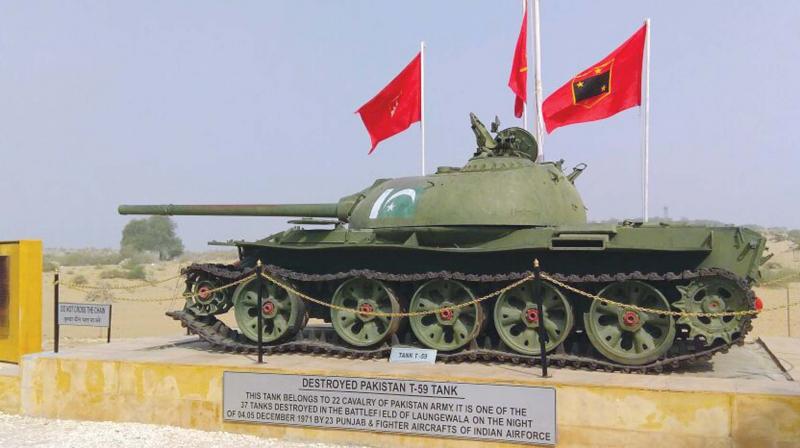Longewala war memorial on Indo-Pak border woos tourists

Chennai: Rewinding 46 years and assaying to visualise the supreme bravery of 120 Indian soldiers who defended India's borders in the cold December desert night at Longewala, a border town in the Thar Desert in western Jaisalmer (Rajasthan) is something spine chilling, literally.
The Indian soldiers ran from bunker to bunker, lobbing grenades at the approaching enemy forces and laying mines blowing tanks. Chinese-made tanks used by Pakistan ended up in smoke when the 23rd battalion of the Punjab regiment, initially startled at the hushed activity, decided to respond to the crisis by taking on the aggressor. Indian Army's 23rd battalion, Punjab Regiment, commanded by Major Kuldip Singh Chandpuri, who was honoured with Mahavir Chakra, is the hero of the Battle of Longewala. He led his men to a brilliant victory despite his superiors giving him either or option of remaining firm or beating a hasty retreat in the night.
"And it was not an easy task to decide to taken on over 2,000 Pakistani soldiers who were fully equipped. Pakistan appeared to have chosen full moon (pournami) night to capture Indian territory right upto Jaisalmer from Longewala," a major guarding the post at Longewala explained. The small group of journalists from Chennai who were taken to the frontier position in Rajasthan by the PIB, recently, were greeted by an uncanny silence as the friendly Major paused.
Before the officer could commence his terse narration pointing out at the captured Pakistan tanks that are still preserved in the Longewala war memorial, the visiting team sought to know if there would be shelling from across the border.
"No," he replied. "Things have been quiet in this desert region but we are not taking any chances. We continue to maintain vigil and are in an advantageous position," he added. Many of us heaved a sigh of relief! Though walking is rather difficult on the smooth sandy surface, one could not imagine how the soliders ran from one bunker to another or even dared to lay mines and blew up the advancing tanks.
For south Indians, especially those from TN, with about 1,076 km coastline and three seas lapping the shores, it is pretty difficult to imagine the troubles faced by the people in states like Rajasthan which has borders with a hawkish Pakistan - though the same could be said for any north Indian for that matter when it comes to the travails of the TN fishermen who frequently face problems at sea.
Thankfully, Ockhi eclipsed the Lankan coast guard firing incidents and highlighted the yeoman service rendered by the Indian Navy, Indian Coast Guard and Indian Air Force in the search and rescue operation - Sahayam, in the Lakshadweep and Minicoy Islands.
The Pakistani plan to reach Longewala, Ramgarh and Jaisalmer was frustrated by the Indian Army despite Pakistan launching the offensive at 12:30 am of December 4, 1971. Only next morning the Indian Air Force was able to direct HF-24 Maruts and Hawker Hunter aircraft to assist the Indian soldiers. Pakistan's Sherman tanks and T-59 - Type 59 Chinese tanks are displayed at the memorial.
The Longewala War Museum at Jaisalmer, like the battle memorial is a huge draw. Several hundreds of Indian and foreign tourists visit the sites on a daily basis. And in the vicinity, the Tanot Mata temple, where the BSF has established its outpost, is another sensitive spot that keeps the BSF constantly on their toes. Despite the pressures, the Indian Army and BSF men are cordial in receiving the Indian visitors and allowing the tourists to enjoy the eerie silence on desert sands.
Chennai or madras too has fair share of glorious role in wars
Chennai or Madras as it was known in the past, too has its fair share of glorious role in World Wars and also the Indo-Pak wars.
The Victory War Memorial, south of the historic Fort St George near the 13-km-long Marina beach, was originally built to commemorate the victory of the allied armies during World War I (1914-1918) and later became the victory war memorial for World War II (1939-1945), erected in the memory of those from the Madras Presidency who lost their lives in the wars. Later, it included inscriptions of 1948 Kashmir Aggression, 1962 War with China and the Indo-Pakistan War.
This circular rock and marble structure was constructed in the area that formerly housed the coastal belfry. It was formerly called the Cupid's bow.
The Madras War Cemetery and memorial in Nandambakkam, here, was established to receive Wo-rld War II graves from many civil and cantonment cemeteries in the south and east of India where their permanent maintenance could not be assured. The cemetery contains 856 Commonwealth burials of the World War II and was established in 1952 by the Imperial War Graves Commission, now known as the Commonwealth War Graves Commission (CWGC), to pay tribute to the men and women who sacrificed their lives in World War II. It is currently maintained by the CWGC in partnership with Government of India. It is located on Mount-Poonamallee Road, Nandambakkam, about 5 km from the airport and 1 km from St Thomas Mount. The cemetery is open to the public.
War memorial or museums can be excellent spots to attract tourists and to educate and inform them about the heroic deeds in the past. Such structures not only extol the greatness of the region but also make one proud.

